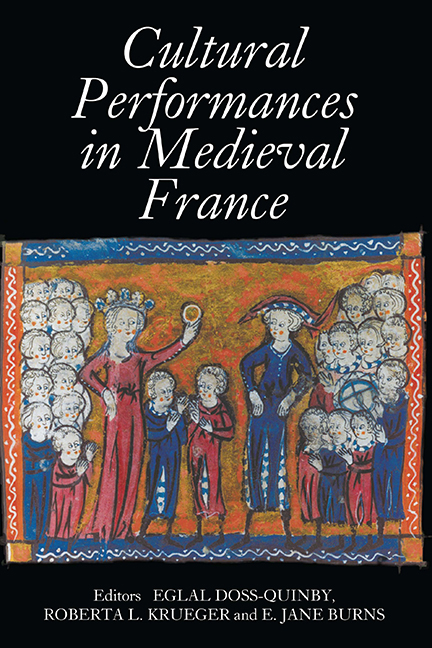Book contents
- Frontmatter
- Contents
- List of Illustrations
- Contributors
- Introduction
- Nancy Freeman Regalado, Curriculum Vitae
- PART I POETIC AND MUSICAL PERFORMANCES
- PART II PERFORMING SEXUAL AND SOCIAL IDENTITIES
- Intimate Performance: An Ivory Writing Tablet Cover at The Cloisters
- A Cultural Performance in Silk: Sebelinne's aumousniere in the Dit de l'Empereur Constant
- Acting Like a Man: Performing Gender in Tristan de Nanteuil
- Amorous Performances: The Aventure de l'espee vermeille in Perceforest
- Historicizing Performance: The Case of the Jeu de Robin et Marion
- The Protean Performer: Defining Minstrel Identity in Tristan Narratives
- PART III DEVOTIONAL PRACTICE AND TEXTUAL PERFORMANCE
- PART IV PERSUASIVE PERFORMANCES
- PART V RE–ENACTMENTS AND LEGACIES
- Tabula Gratulatoria
- Tabula Gratulatoria
The Protean Performer: Defining Minstrel Identity in Tristan Narratives
from PART II - PERFORMING SEXUAL AND SOCIAL IDENTITIES
Published online by Cambridge University Press: 24 October 2017
- Frontmatter
- Contents
- List of Illustrations
- Contributors
- Introduction
- Nancy Freeman Regalado, Curriculum Vitae
- PART I POETIC AND MUSICAL PERFORMANCES
- PART II PERFORMING SEXUAL AND SOCIAL IDENTITIES
- Intimate Performance: An Ivory Writing Tablet Cover at The Cloisters
- A Cultural Performance in Silk: Sebelinne's aumousniere in the Dit de l'Empereur Constant
- Acting Like a Man: Performing Gender in Tristan de Nanteuil
- Amorous Performances: The Aventure de l'espee vermeille in Perceforest
- Historicizing Performance: The Case of the Jeu de Robin et Marion
- The Protean Performer: Defining Minstrel Identity in Tristan Narratives
- PART III DEVOTIONAL PRACTICE AND TEXTUAL PERFORMANCE
- PART IV PERSUASIVE PERFORMANCES
- PART V RE–ENACTMENTS AND LEGACIES
- Tabula Gratulatoria
- Tabula Gratulatoria
Summary
In the midnight quiet of June 8, 2004, in her French Department office at New York University, Nancy Freeman Regalado and I celebrated her sixty-ninth birthday by sealing a Federal Express box containing the manuscript for Performing Medieval Narrative, the volume we had edited with Evelyn (Timmie) Birge Vitz. Fortified by Nancy's favorite fig cookies, we wrapped up years of work on our book dedicated to the performance of medieval stories. Work on this volume made me more keenly aware than ever before of the centrality of performance and the performer in medieval French culture.
In this essay I examine how authors construct and define the most pivotal figure in that performance culture: the minstrel. I focus particularly on the latetwelfth-century anonymous Folie Tristan of Oxford and the “Tristan ménestrel” episode in Gerbert de Montreuil's Continuation de Perceval from 1226–30. In both of these verse narratives an exiled Tristan disguises himself as a minstrel in order to enter Marc's court and visit his beloved, Yseut. In the Folie, Tristan adopts the mask of a minstrel-fool and travels alone to Tintagel. There he amuses Marc's court with a mixture of true and fictive stories in which he claims to be not Tristan, but Tantris, the minstrel-harpist as whom Tristan masquerades in other medieval narratives. In the Continuation, Tristan recruits Gauvain and twelve other knights of Arthur's Round Table to join him in minstrel disguise. Together they travel to Lancïen and present themselves as minstrel-watchmen to Marc's court where, still masked as minstrels, they fight on the king's behalf in his tournament against the Roi des Cent Chevaliers. Both Gerbert and the author of the Folie use the terms menestrel and jogleor or jugleres to refer to Tristan (and his companions) in disguise, yet their concepts of the minstrel differ remarkably.
The disguise passages in the two narratives reveal how different authors create the same character, Tristan, and how they define the minstrel disguises he assumes. In addition, the Folie demonstrates how one author constructs two different minstrel disguises – those of the minstrel-fool and the minstrel-harpist – in a single narrative. Analysis of the signs authors use to create Tristan's minstrel masks shows the complexity and flexibility of authorial notions of the medieval minstrel, and more generally of character.
- Type
- Chapter
- Information
- Cultural Performances in Medieval FranceEssays in Honor of Nancy Freeman Regalado, pp. 109 - 120Publisher: Boydell & BrewerPrint publication year: 2007



